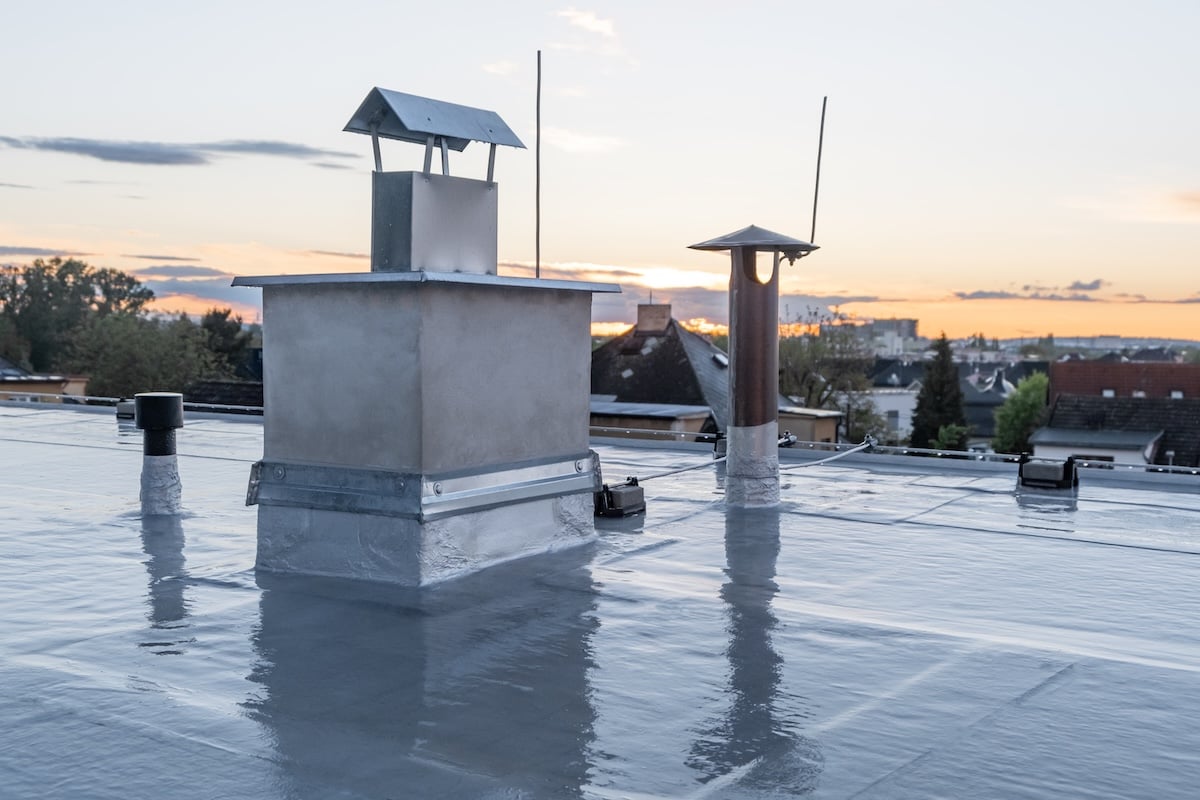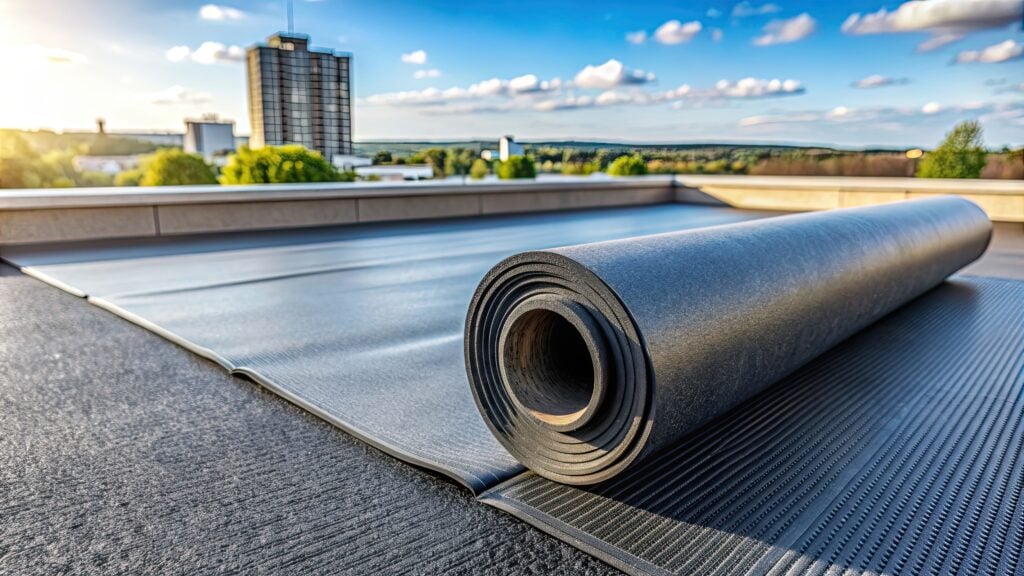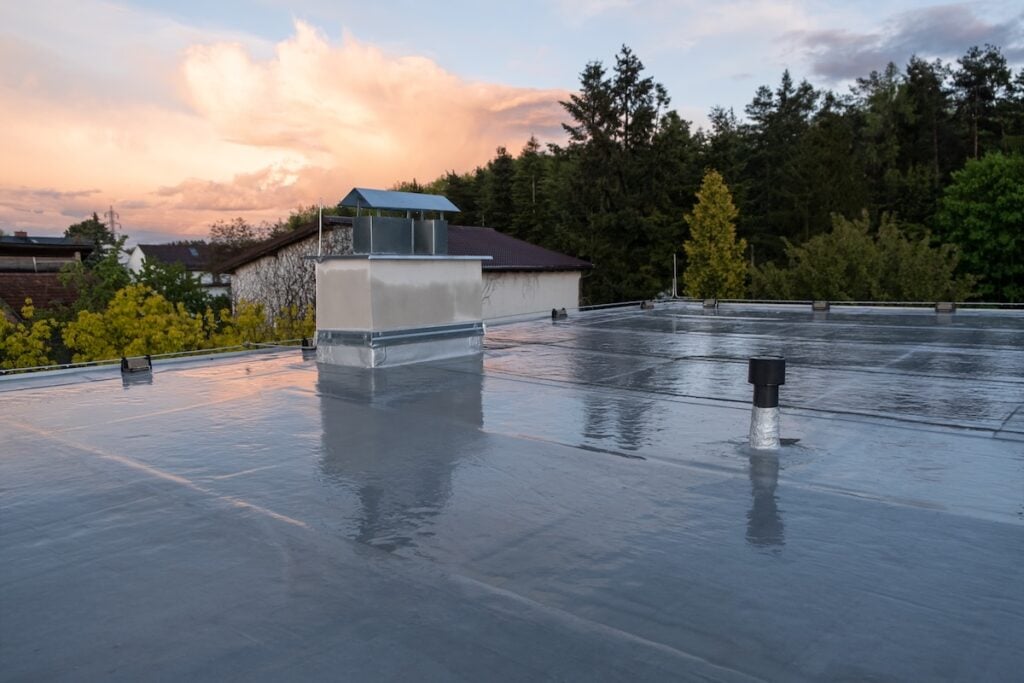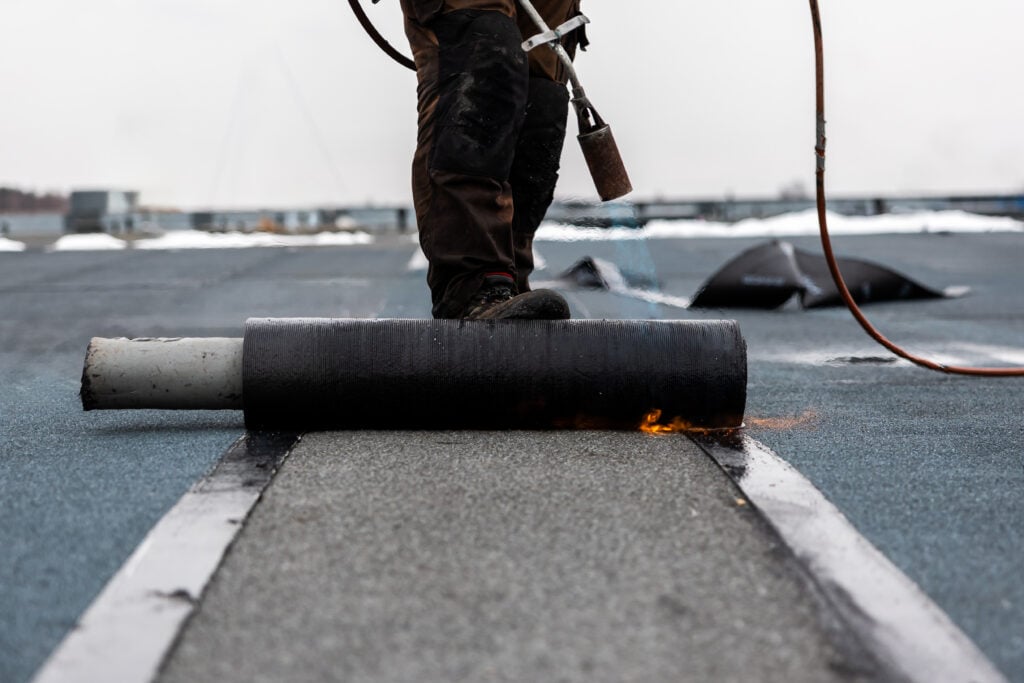

8 Benefits Of Rubber Roofing With Pros & Cons
Posted August 5th, 2025 | 7 min. Read
Choosing the right roofing material for your property requires careful consideration of durability, cost, and performance. Rubber roofing has emerged as a popular solution for both residential and commercial buildings, offering unique advantages that make it worth serious consideration.
This comprehensive guide examines everything you need to know about rubber roofing systems. We’ll explore the key benefits that make rubber roofing attractive to property owners, discuss potential drawbacks you should consider, and help you determine if this material fits your specific needs. You’ll discover:
- The top benefits of rubber roofing systems
- Potential disadvantages to consider
- Installation and maintenance requirements
🤔 What Is Rubber Roofing?

Rubber roofing refers to roofing systems made from synthetic rubber materials, primarily EPDM (Ethylene Propylene Diene Monomer) or TPO (Thermoplastic Olefin). These materials create a waterproof membrane that protects your building from the elements.
EPDM rubber roofing is the most common type, made from synthetic rubber compounds that create a durable, flexible membrane. This material has been used successfully for decades on commercial buildings and is gaining popularity for residential applications.
TPO roofing combines rubber with plastic polymers, offering similar benefits with enhanced energy efficiency. Both types provide excellent protection for flat or low-slope roofs commonly found on commercial buildings and some residential structures.
Types Of Rubber Roofing Materials
- EPDM Rubber Roofing: Known for its durability and weather resistance, EPDM is flexible enough to handle temperature changes without cracking, making it ideal for areas with significant climate variations. Available in black or white, the white option enhances energy efficiency in hot climates.
- TPO Roofing Systems: Combining rubber and thermoplastic properties, TPO offers superior waterproofing with heat-welded seams for stronger, longer-lasting joints. Its white or light color options improve energy efficiency, making it a popular choice for energy-saving applications.
- Modified Bitumen Roofing: A hybrid of rubber polymers and asphalt, this system provides flexibility and cost-effective performance, often used for commercial and residential buildings requiring a balance of durability and affordability.
✅ 8 Key Benefits Of Rubber Roofing

Rubber roofing is highly durable and long-lasting, making it a cost-effective solution for protecting your home. It’s also eco-friendly and resistant to extreme weather conditions, ensuring reliable performance over time.
1. Outstanding Durability and Longevity
Rubber roofing systems can last 20 to 30 years with proper installation and maintenance. The material resists cracking, splitting, and deterioration from UV rays, making it an excellent long-term investment for your property. This extended lifespan means fewer replacements over the decades, providing excellent value for your roofing investment.
2. Superior Weather Resistance
Your rubber roof will withstand extreme temperature fluctuations, from freezing winters to scorching summers. The material remains flexible in cold weather and won’t become brittle or crack like some other roofing materials. This flexibility is particularly important in climates with significant temperature variations.
3. Excellent Waterproofing Properties
The seamless design of rubber roofing creates an impermeable barrier against water infiltration. When properly installed, these systems provide outstanding protection against leaks and water damage. The large membrane sheets minimize seam joints, which are often the weakest points in roofing systems.
4. Cost-Effective Installation
Rubber roofing typically costs less to install than many traditional roofing materials. The large membrane sheets cover extensive areas quickly, reducing labor time and overall project costs. This efficiency makes rubber roofing an attractive option for budget-conscious property owners.
5. Low Maintenance Requirements
Once installed, rubber roofing requires minimal ongoing maintenance. Regular inspections and occasional cleaning are usually sufficient to keep your roof in excellent condition. This low-maintenance characteristic saves you time and money over the roof’s lifespan.
6. Energy Efficiency Benefits
White or light-colored rubber roofing reflects sunlight and heat, reducing cooling costs during hot weather. This reflective property can significantly lower your energy bills over time, especially in warmer climates where cooling costs represent a major expense.
7. Environmentally Friendly Option
Many rubber roofing materials contain recycled content and can be recycled at the end of their useful life. This makes them an environmentally responsible choice for eco-conscious property owners who want to minimize their environmental impact.
8. Easy Repair Process
When damage does occur, rubber roofing repairs are typically straightforward and cost-effective. Small punctures or tears can often be patched without replacing large sections of the roof. This repairability extends the roof’s life and keeps maintenance costs manageable.
⚠️ Potential Disadvantages Of Rubber Roofing

Understanding the potential disadvantages of rubber roofing is crucial to making an informed decision for your property. While it offers durability, being aware of its limitations can help you determine if it’s the right fit for your needs.
Limited Aesthetic Appeal
Rubber roofing may not offer the visual appeal of traditional materials like shingles or tiles. The flat, industrial appearance might not suit all architectural styles or personal preferences. However, this limitation primarily affects properties where the roof is highly visible from ground level.
Vulnerability to Sharp Objects
While durable overall, rubber roofing can be punctured by sharp objects like falling branches, tools, or debris. Regular inspection helps identify and address these issues before they become major problems. Property owners should be mindful of overhanging trees and potential sources of sharp debris.
Seam Vulnerability
Although rubber roofing has fewer seams than many alternatives, the seams that do exist can become weak points over time. Proper installation and maintenance are crucial for preventing seam-related issues. Quality installation by experienced professionals minimizes this concern.
Professional Installation Required
While rubber roofing installation may seem straightforward, proper installation requires professional expertise. Improper installation can lead to premature failure and void manufacturer warranties. The initial investment in professional installation pays dividends in long-term performance.
🛠️ Installation Process And Requirements

Understanding the installation process and requirements is crucial to ensure a smooth setup without errors. It helps you prepare the necessary tools and meet system compatibility needs beforehand.
Professional Assessment
Your roofing contractor will evaluate your existing roof structure, drainage, and any specific requirements for your building. This assessment ensures the rubber roofing system will perform optimally and identifies any structural issues that need addressing before installation.
Deck Preparation
The roof deck must be clean, dry, and properly prepared before installation. Any existing roofing material may need removal, and the deck should be inspected for damage or weakness. Proper preparation is essential for long-term performance and warranty compliance.
Insulation And Base Layers
Proper insulation improves energy efficiency and prevents condensation issues. Base layers provide additional protection and create a smooth surface for the rubber membrane. These components work together to create a complete roofing system.
Membrane Installation
Professional installers position the rubber membrane across your roof, ensuring proper overlap at seams and correct adhesion to the deck. This step requires expertise to avoid wrinkles, gaps, or other installation issues that could compromise performance.
Seam Sealing And Finishing
All seams receive proper sealing using manufacturer-approved adhesives or welding techniques. Flashing around penetrations and edges ensures complete waterproofing. Attention to detail during this phase determines the system’s long-term success.
👨🔧 Choose Certified Roofing Solutions For Superior Rubber Roofing
When it comes to rubber roofing, Certified Roofing Solutions is the team you can trust to deliver exceptional results. With years of experience, industry-leading certifications, and a commitment to using only the highest quality materials, we ensure your roof stands the test of time. Our proven track record and dedication to excellence make us the trusted choice for commercial property owners across Florida.
Ready to invest in durable, cost-effective protection for your property? Contact us today to schedule your free consultation. Let us help you secure a roofing solution you can depend on for decades to come!

